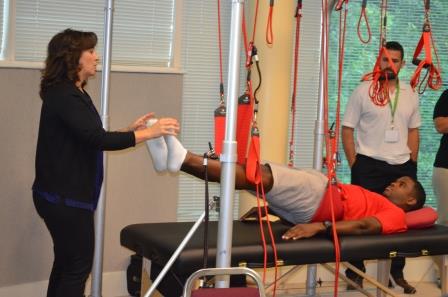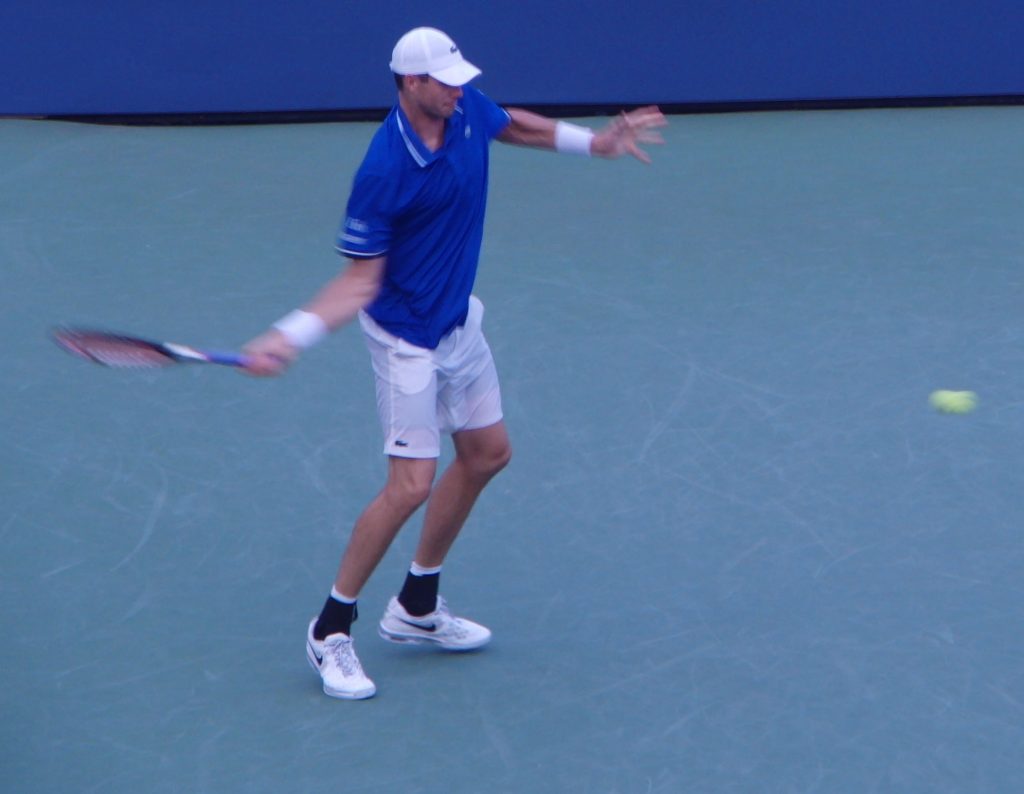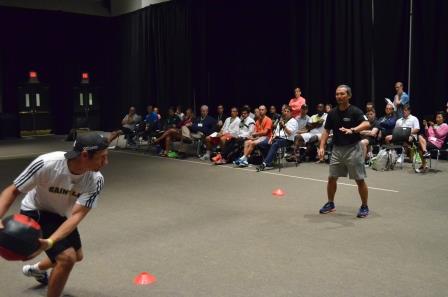MEMBER LOG IN
Categories
Links
Category Archives: Injury Prevention
The Importance of Hip Range of Motion in Tennis
By Patrick Aubone, CTPS & Dr. Mark Kovacs, CTPS, MTPS
Hip range of motion in tennis is one of the most challenging areas to train and treat. It is well understood the importance of the hips in the tennis player both from a movement standpoint, but also from a stroke efficiency perspective. Limitations in hip range of motion has been linked to lower back issues and also shoulder and upper extremity problems. In tennis hip range of motion is important in order to transfer energy from the lower body to the upper body through the kinetic chain. Repetitive rotational stress in the lower extremities playing tennis can lead to sport specific range of motion adaptations. Such adaptations may increase the risk of injury to other joints along the kinetic chain.
The increase risk of injury due to lack of mobility is worrisome at the recreational level. Common injuries seen include shoulder injuries, tennis and golfers elbow, abdominal pulls, groin and hamstring pulls. Some if not all of these can possibly be prevented by increasing the hips range of motion. Abdominal strains are linked to hip flexion contractures. A hip flexion contracture is caused by sitting for extended periods of time. In one study hip flexion contractures were linked to abdominal strains with iliopsoas tightness. Tight ligaments and muscles were more related to injury in men not in women in one study done on college athletes (Krivickas 1996)
Increasing range of motion is important because decreased hip strength may be associated with poor control of lower extremity motion during weight bearing activities. A lack of hip strength can lead to abnormal patellofemoral motions and pain. Individuals suffering from patellofemoral pain syndrome demonstrate significant impairments in hip strength. The question now is how can one increase their range of motion? The following exercises will help increase quadriceps and hamstring flexibility along with increasing hip range of motion.
- Figure 4 stretch – Lying flat on your back place the outside of the right foot on the left quadriceps. Next place the right hand through the triangle and grab the left shin with both hands. Next pull the left leg towards your chest as far as possible stretching the right glute.
- Single Leg Flexion – Start with one leg back with the knee downward flat on the ground while the opposite leg is flexed at 90 degrees. Make sure that your forward foot is in line with the same side hand in order to keep your shin vertical. Next place the hand on the foot locking it in place and sprawl the opposite leg back and drop move the forward knee slightly outward. From here move in and out with the front leg to loosen up the hip capsule.
- Hip External Rotation – Sit upright with your legs straight out in front of you. Set up by learning toward one side and swing the opposite leg forward perpendicular to your body. Next extend your back leg keeping the foot flat on the ground and maintaining a flat back. Slowly lower your chest towards the ground. Make sure to hold the front foot down, one you have reached your limit experiment by rotating your torso in different directions still maintaining a flat back.
Here are 10 common hip stretches that can be a valuable addition to an athletes training – http://dailyinformator.com/10-piriformis-stretches-to-help-you-get-rid-of-sciatica-hip-and-lower-back-pain/
These are just a few exercises that can help increase range of motion in the hips and help prevent injuries. Because of the rotational nature of the sport it is vital to have a healthy kinetic chain from the ground up. The hips and glutes play an important role in the entire kinetic chain and their flexibility and range of motion is very important.
Here is another great resource on stretching the hip (as well as many other body parts) in the Dynamic Stretching book and the Stretching Strap Workbook at the link http://mark-kovacs.com/products.html
Sources:
https://www.ncbi.nlm.nih.gov/pubmed/25214532
https://www.ncbi.nlm.nih.gov/pubmed/8931525
http://www.jospt.org/doi/abs/10.2519/jospt.2007.2439?code=jospt-site
Patrick Aubone CTPS, MTPS, M.S.
EXOS Phase 1 Mentorship
USPTA Lvl 1
PTR Professional
Simple Exercises That Can Be Done To Potentially Reduce Injuries And Increase Performance
Here is a great video where three of our ITPA professionals (Dean Hollingworth, CTPS, MTPS; Jonny Fraser, CTPS, MTPS and Trevor McPherson, CTPS) provide over 200 adult competitive tennis players with some important exercises that can be incorporated into weekly programs. This was a presentation at the Tennis Congress. Watch this video to get some ideas on how best to perform these exercises.
Injuries and Playing Surfaces in Professional and Recreational Tennis
By Patrick Aubone, CTPS & Dr. Mark Kovacs, CTPS, MTPS
Headed into the professional clay court season, common perception is that in tennis surface matters. As we get older, clay courts are the surface of choice. Continue reading
Posted in Injury Prevention, Surfaces
Leave a comment
Tennis Hip Syndrome How can my tight hip cause shoulder and elbow pain?
Guest blog post by Brian Nathanson, DC, CTPS
This is the question I hear many times when I tell my rotator cuff and tennis elbow clients they have Tennis Hip Syndrome. Over the years I have had the pleasure of working with many tennis professionals and passionate amateurs. During this time I have noticed a very common pattern yet to be named. For lack of a better term I have decided to call it Tennis Hip Syndrome. Continue reading
Posted in Injury Prevention, Tennis Elbow
Leave a comment
Presentation Slides From Performance Lectures at 2014 Tennis Medicine & Performance Conference
On July 19th and 20th, 2014 the iTPA and STMS combined to host the 2014 Tennis Medicine & Performance Conference in Atlanta, Georgia (USA). This great 2 day education event brought together experts in all aspects of tennis medicine, science, performance training and coaching. As many of the iTPA family could not attend in person we are providing some resources for our members in over 24 countries. In this post you will see a selection of the performance focused presentation slides.
If you are interested in viewing 10 of the most well-attended sessions during the conference, please visit the link below with the ability to subscribe to over 7 hours of video from the conference 2014 Tennis Medicine & Performance Conference Videos
Medicine/Injury Prevention Slide Presentations from the 2014 Tennis Medicine & Performance Conference
If you were unable to attend the 2014 Tennis Medicine & Performance Conference in person, you missed one great educational event. However, we want to provide great value to iTPA members and we are including a selection of the medical/injury prevention presentation slides from the 2014 Tennis Medicine & Performance Conference below. If you are interested in viewing 10 of the most well-attended sessions during the conference, please visit the link below with the ability to subscribe to over 7 hours of video from the conference 2014 Tennis Medicine & Performance Conference Videos Continue reading
Continue reading
Physical and Physiological Demands of Tennis
By Josh Bramblett, iTPA Staff
The modern game of tennis continues to progress and evolve. There are numerous ways for any player at any skill level to participate. The physicality of tennis continually grows along with the demands placed on the body. The focus of the game has changed from finesse to power and speed. Continue reading
Heat at the Australian Open
By Josh Bramblett, iTPA Staff
For 4 days at the first week of the Australian Open a heat wave swept over Melbourne that has not been seen in a century. During the first week of the tournament (Tuesday through Friday), temperatures rose to over 104 degrees Fahrenheit. The intense heat wave has resulted in: Continue reading
Posted in Australian Open, Heat, Injury Prevention
Leave a comment
Ice Baths: Can They Help The Tennis Athlete Recover?
Improving recovery from tough training sessions or intense tournament matches is one area that the TPT or CTPS needs to constantly work on to ensure your players can recover optimally so that the next day of training or competition can be optimized. Although many techniques are used in attempt to improve recovery, this post will focus on Continue reading
Posted in Injury Prevention, Recovery
Leave a comment


